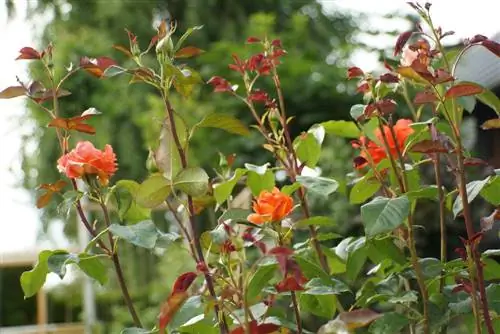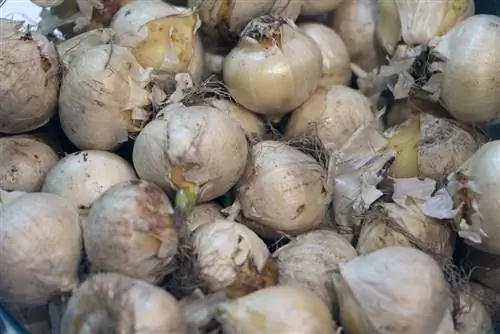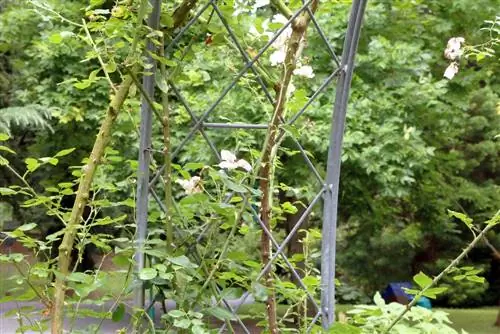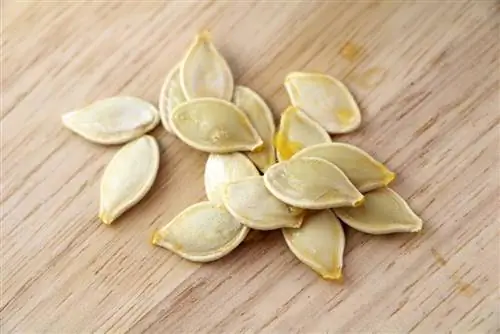- Author admin [email protected].
- Public 2023-12-17 03:39.
- Last modified 2025-06-01 06:48.
If you want to transplant your rhododendron, you always have to ensure the right location. Different criteria determine what constitutes the right place, for example the nature of the soil and its pH value. In addition to the appropriate solution for the location, the correct procedure when digging out and inserting is essential for the continued existence of the rhododendron. In addition, as a hobby gardener you should know about various diseases that can affect the plant.
Soil texture
The rhododendron is planted in spring or autumn, if possible at the beginning of the season. The reason is: the plant gets enough time to spread its roots before frost. Ideally, however, the transplant should be carried out in May after the Ice Saints. The period from the beginning of September to mid-November can also be used. A soil with a slightly acidic pH value is required. Ideally, this is a value of 4 to 5.5. You can get test strips from specialist retailers with which you can determine the value based on the color displayed. In addition, the soil should be in an environment with relatively high humidity and in partial shade. The choice should be a place protected from the wind to prevent later drying out by wind. A sunny location can also be chosen as long as the humidity is sufficiently high. If you can offer it, plant the rhododendron in low-lime, loose soil with humus that must be well permeable to air and water. The soil conditions for the rhododendron in a nutshell:
- transplanting possible in spring and autumn (start as early as possible in autumn)
- alternatively beginning of September to mid-November
- pH value slightly acidic; between 4 and 5, 5
- Place with high humidity in partial shade
- sheltered from the wind
- Soil: low in lime, loose, rich in humus, permeable to air and water
Tip:
If the pH value is too high, you can reduce it by adding peat or special rhododendron soil. This works the soil in the favorable direction and lowers the pH value to the required value.
Unearth
So that the rhododendron can be transplanted completely and without damage, it must be carefully pulled out of the ground. Use a spade to create a trench around the bush. The diameter of the excavation is three quarters of the size of the bush. Once the circle has been drawn around the rhododendron, you poke diagonally under the plant to free the stuck roots from the soil. The entire bush is pulled out of the ground with the bale and then transported to the new location. If necessary, tie the branches together with a string to avoid breakages during transport.
Prepare the location and plant
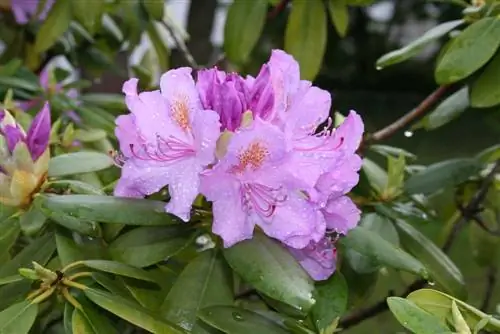
Dig a hole with a spade. This should be twice the size of the globe. Then loosen the surrounding soil to support the rhododendron in growing. Fill the hole with peat or rhododendron soil and water the area before putting the plant back into the ground. Make sure to plant the plant at the same height as in the previous location. This step is essential for the he alth of the rhododendron because if you insert the ball too deep, the roots will suffer. The remaining hole around the bush is filled with peat or the special soil and watered again.
The details again in the short description:
- Dig hole; double size of the bush
- Loose the soil around the trench
- Fill the hole with peat or rhododendron soil; pour
- Place the plant at the same height as the previous place
- close remaining hole with peat or rhododendron soil
Tip:
For watering, use low-lime water, for example rainwater or stale tap water.
Fertilize
The right fertilizer helps the rhododendron grow and makes it easier for the roots to spread. Nutrients are added via organic fertilizer or rhododendron fertilizer. The right time to fertilize is late March or early April. Two to three months later, nutrients are added again - at the end of June to the beginning of July.
Diseases
The trigger for an illness is usually an incorrectly chosen location. Fungal infestation is one of the most common consequences of unsuitable locations. The leaves can also turn brown and the buds can dry. Drying out is accompanied by death. Bud rot can also occur. The so-called Alpine rose apples are very striking; red, gelatinous bumps. Various pests can also become a problem for rhododendrons. Including the weevil and the rhododendron cicada. Falling and brown leaves are the result of an infestation by rhododendron mesh bugs. These eat at the midrib and damage the plant.
General Care
When the flowering is over, you twist the remaining flower residues off the cane. This measure is important to prevent seeds from forming again. This would cost the rhododendron unnecessary energy. In addition, the growth of new inflorescences is supported, so that the young and strong shoots are responsible for reproduction. The rhododendron needs to be moistened in moderation. As soon as the soil has dried out, you have to water.
Cutting
A regular blend is not an urgent necessity. If the bush becomes too large for its current location, transplanting is possible. If you still want to cut, this should be done after the flowering period or at the end of winter. You can cut away the first flowers. Whether and how pruning is necessary depends on the type of rhododendron and its vivacity. If you propagate your plant from cuttings, you can cut it if the plant is he althy. Caution is advised with refined specimens, as they often do not accept offcuts well. Correct cutting in a nutshell:
- cut after flowering or at the end of winter
- The need for pruning depends on the type and vitality of the plant
- only cut rhododendrons that have been propagated from cuttings
- grafted plants do not tolerate pruning well
Frequently asked questions
How much space does a rhododendron need?
The space required by the alpine rose depends on the type and current size. If a bush becomes too large for its current location, replanting is essential. When inserting the root, you are guided by the volume of the root ball.
The rhododendron has yellow leaves. What could be the reason for this?
Often the climate of the soil is not right. Either the earth is too dry or too wet. It may be necessary to add fertilizer. You should add nutrients through fertilizer twice a year.
Can you keep rhododendrons in planters?
This is possible without any problems. It is important that you use the right size bucket. This should be at least as big as the bush itself, but not smaller. If the rhododendron becomes too big for the container, the only option is to transplant it into the garden.
What you need to know about transplanting rhododendrons
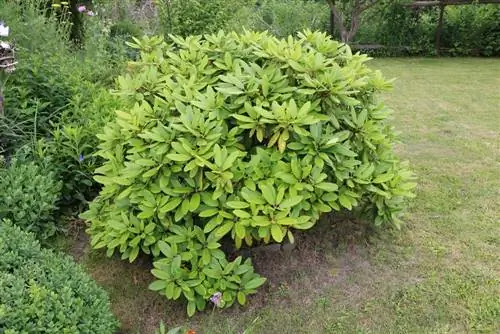
A rhododendron forms very shallow roots, so it is relatively easy to transplant it even as a large bush. A rhododendron is planted and transplanted either in spring or autumn. In autumn, this should be done as early as possible so that the plant has enough time to form sufficient roots before the first ground frosts.
Prepare the floor
- Rhododendron is one of the few plants that require acidic soil. This should have a pH value of around 4 to 5.5.
- If the soil in which the rhododendron is to be transplanted is not acidic enough, it can be improved by incorporating peat.
- Alternatively, part of the ground can be dug up and filled with special rhododendron soil.
- Such rhododendron soil can also be used for azaleas, camellias and other plants that require a low pH value.
Dig up rhododendron
- In order to transplant a rhododendron, it must first be dug up.
- To do this, use a spade to dig a trench around the bush, which should be about 3/4 as large in diameter as the bush.
- From there you can poke the spade diagonally under the plant so that the roots slowly loosen.
- This allows the bush to be lifted out of the ground with a ball. It will then be transported to the new location.
Plant in the new location
- A planting hole is dug at the new location, which should be about twice the size of the bale.
- So that the rhododendron can form new roots, the surrounding soil should also be loosened up a bit.
- Peat or rhododendron soil is poured into the hole and watered before the bush is placed in it.
- The bush should then be at the same height as in the old place.
- Under no circumstances should a rhododendron be planted too deep, otherwise the roots will quickly suffer.
- Then the rest of the planting hole is filled with peat or rhododendron soil.
- Finally, there is plenty of watering again.
Pouring
For a rhododendron, you should only use low-lime water, i.e. rainwater or stale tap water, if possible, because lime is poorly tolerated by this plant. To make it easy to water the rhododendron after transplanting, it is helpful to create a watering edge. A small wall of earth is created through which the water cannot flow away to the sides. So that the transplanted rhododendron receives enough nutrients during the growing period, it should receive some fertilizer, which is only raked in lightly. In addition, the ground can then be covered with bark mulch to protect the roots from heat and cold.



